| EngakujiTemple (円覚寺) |
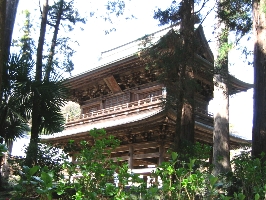
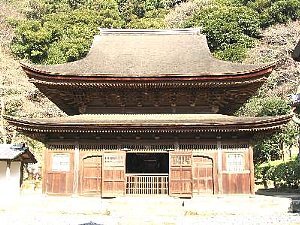
Full name: Zuirokuzan (瑞鹿山)
Engakuji
Denomination: Rinzai sect
(臨済宗)
Location: Next to the east side exit of
Kita-Kamakura Station on the Yokosuka Line.
History:
Under the patronage of Hojo Tokimune (北条時宗, 1125-84), the eighth
regent, the temple was founded in 1282 for the repose of the souls
of those who had died in the battles between Japan and the Mongol or
Yuan (元) dynasty of
China.
The Mongol forces
invaded the northern part of Kyushu Island in 1274. Fierce battles
were fought and many lives were lost. Finally, a storm which later
came to be called Kamikaze or the divine wind, wrecked their ships,
and drowned countless soldiers and sailors who had been on board.
After a second attempt failed in1281, the Mongols gave up their
ambition to controll Japan for ever. They were regarded as hateful
enemies, but death was an equalizer, so the souls of the foe
received due respect.
The founding priest of Engakuji was Mugaku Sogen (無学祖元, 1226-86),
a.k.a. Bukko Kokushi (仏光国師), invited from China by Tokimune. Sogen
arrived in 1279 and served at first as the fifth head priest of
Kenchoji (建長寺), and later, in 1282, presided as the founding priest
of Engakuji.
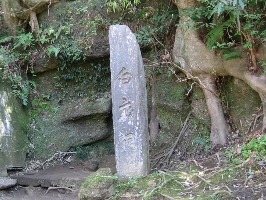 The"Engaku" (円覚) in the temple
name 円覚寺 is said to have derived from the fact that when
construction work began in the grounds in 1277, a container was
unearthed that held a scripture of the Engaku-kyo Sutra (円覚経). As
for the"Zuiroku" (瑞鹿,"Lucky Deer") in the sango, 瑞鹿山, this was
derived from the legend that when Sogen was giving his first sermon
at the opening ceremony, a herd of white deer appeared unexpectedly
and listened to him. This was thought to be a good omen. Associated
with this legend is a shallow cave, Byakurokudo (白鹿洞), in the rear
of the grounds.
The"Engaku" (円覚) in the temple
name 円覚寺 is said to have derived from the fact that when
construction work began in the grounds in 1277, a container was
unearthed that held a scripture of the Engaku-kyo Sutra (円覚経). As
for the"Zuiroku" (瑞鹿,"Lucky Deer") in the sango, 瑞鹿山, this was
derived from the legend that when Sogen was giving his first sermon
at the opening ceremony, a herd of white deer appeared unexpectedly
and listened to him. This was thought to be a good omen. Associated
with this legend is a shallow cave, Byakurokudo (白鹿洞), in the rear
of the grounds.
Sogen
was highly admired for his courage and self-possession. When he was
in China, the Yuan (元) forces, in their attempt to conquer the
Southern Sung dynasty (南宋), advanced into the area where Sogen had
taken refuge in a temple called Noninji (能仁寺). When soldiers broke
into the temple and threatened to slay him, he calmly composed a
four-line poem. In it, he deplored how the world had become so small
that there was no space to rest his staff and he said he found no
pleasure in knowing that both the law and humans are simple
nothingness.
He admonished
the warriors to use prudence in drawing their swords and declared
that should the soldiers behead a priest like him who sees that all
is void, their action would amount to no more than brandishing a
sword in the spring wind. The soldiers, it is said, withdrew in
admiration.
(The
invitation extended to Sogen in 1279 was due to an unexpected event.
Tokimune, in 1277, had already started the construction of a new
temple. The regent had asked Rankei Doryu (蘭渓道隆, 1213-78) at
Kenchoji Temple to be the founding priest, but the sudden death of
Doryu in 1278 brought the work to a stop until Sogen assumed the
office in 1282.)
Records
tell of the great size of the temple: in 1283 more than 250 people
lived here, including 100 priests and the same number of officials
and workers. The Engakuji Keidai Ezu (円覚寺境内絵図), an illustrated map
of the temple made between 1330 and 1342, shows that the Somon Gate
(総門), Sammon Gate (山門), Butsuden Hall (仏殿), Hatto Hall (法堂, built in
1323), stood in a straight line, similar to the Zen-style formation
of temple structures. There were more than 40 sub-temples within the
grounds.
Even after 1333
and the downfall of the Hojo who had supported the temple, Engakuji
was able to maintain its prosperity under Muso Soseki (夢窓疎石,
1275-1351), who was trusted by Emperor Go-Daigo (後醍醐天皇, 1288-1339)
and the Ashikaga family (足利). However, successive fires almost
consumed the temple and it fell into decline from the Muromachi
period (室町時代, 1336-1573) through the Edo period (江戸時代,
1603-1867).
In 1875, Imakita
Kosen (今北洪川, 1816-1892) became the 202nd head priest and restored
the temple to the status of one of the leading Zen training
institutions in the Kanto region. In 1876, he became the first Chief
Abbot of the Engakuji school of Zen Buddhism. Under Kosen, a number
of eminent priests studied Zen here, among them Shaku Soen (釈宗演,
1859-1919) and Suzuki Daisetsu (鈴木大拙, 1870-1966). Soen became the
207th head priest of the temple and was very active. He was known
even in America and attended the World Parliament of Religions in
Chicago in 1893. Soen, Daisetsu, and other enthusiastic Zen priests
played important roles in spreading Zen to the
West.
Natsume Soseki
(夏目漱石, 1867-1916), the famous novelist and scholar of English
literature in the Meiji period (1867-1912), visited the temple and
practiced Zen meditation. This visit inspired his novel, (門), The
Gate, which was published in 1910.
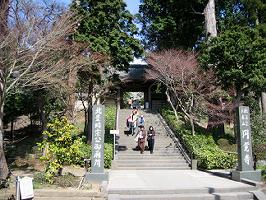
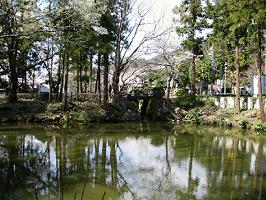
Grounds and structures: The grounds
of Engakuji once extended to the bus road running in front of
Kita-Kamakura Station. The Kita-Gemon (北外門), the North Outer Gate,
of the temple was located where a police box now stands, and the
Minami-Gemon (南外門), the South Outer Gate, was located some 100
meters further south.
The
road between the two gates was once called Medo (馬道) Horse Road,
where even a daimyo (大名) lord had to dismount or step out of his
kago (駕篭), palanquin. A roundabout road still remains beyond the
raised ground to the west, and starts in front of the police box,
running south some 100
meters.
The formal
approach is via Gomabashi Bridge (降魔橋, Evil-Subduing Bridge) from
the bus road. On the side of the bridge is a stone monument
inscribed "大本山円覚寺," Daihonzan Engakuji. The temple gate approach
bisects a pond called Byakurochi (白鷺池), literally, "White Egret
Pond," and the area is designated a Place of Scenic Beauty by the
government. Legend has it that the deity of Tsurugaoka Hachiman, in
the form of a white egret (shirasagi or byakuro, 白鷺), led Mugaku
Sogen to the pond and that was how it acquired the name, Byakurochi.
Unfortunately, construction of the Yokosuka Line in 1889 reduced the
pond to almost half its original size.
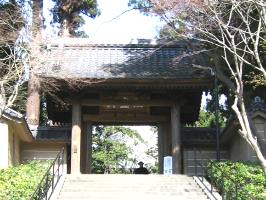
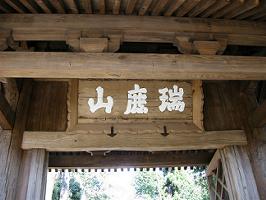
Beyond the pond and
the Yokosuka Line tracks is a flight of stone steps leading up to
the Somon Gate (惣門). A wooden plaque hangs on the beam of the Somon
Gate, bearing the inscription 瑞鹿山, Zuirokuzan, the temple sango
(山号), and the characters are in the handwriting of Emperor
Go-Tsuchimikado (後土御門天皇, 1442-1500). The gate's wooden doors once
belonged to the Outer Gate.
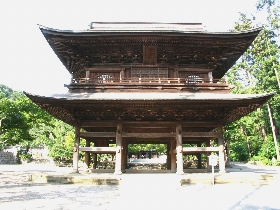
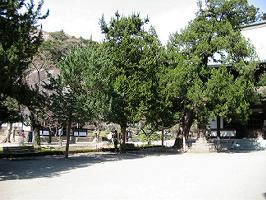
The
massive Sammon Gate is beyond the stone steps lined with tall
Japanese cedars. This gate, rebuilt around 1783, is two-storied and
has a roof covered with copper. A wooden plaque under the eaves has
the inscription 円覚興聖禅寺 Engaku Kosei Zenji in the handwriting of
Emperor Fushimi (伏見上皇, 1265-1317), who at that time was already in
retirement.
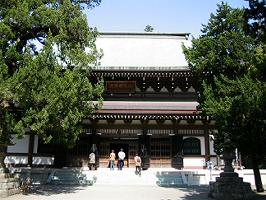
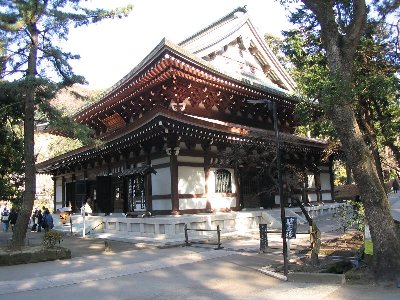
The
Butsuden Hall (仏殿, Main Hall), beyond the Sammon Gate, is behind a
stand of junipers. Rebuilt in 1964 after the original was destroyed
by the Great Kanto Earthquake of 1923, the hall is constructed of
reinforced concrete. Its actual design, though, is an exact copy of
an old plan from 1573, making it worthwhile to take a close look at
the structure and details. The writing on a plaque above the front
entrance reads 大光明宝殿Daikomyohoden and is in the hand of Emperor
Go-Kogon (後光厳天皇, 1338-74).
A
seated statue of Hokan Shaka Nyorai (宝冠釈迦如来 Shakyamuni with a
Jeweled Crown) in the center of the hall was made in the late
Kamakura period (1185/92-1333). The attendants, Bonten (梵天) and
Taishakuten (帝釈天), were made in 1692. On the ceiling is a painting
of a dragon among clouds, Unryu no Zu (雲竜の図), painted by Moriya
Tadashi (守屋多々志) under the supervision of Maeda Seison (前田青邨,
1885-1977).
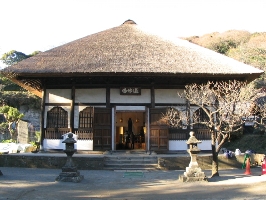
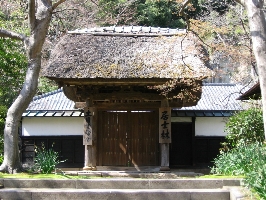
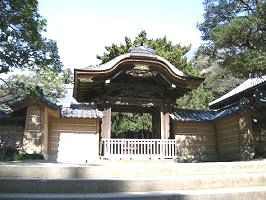
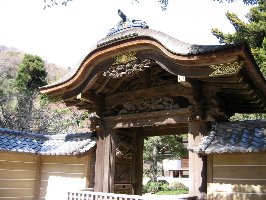
A
thatch-roofed hall Sembutsudo Hall (選仏堂), which was built in 1699 as
a place of Zen meditation and a sutra repository, is to the left of
Butsuden Hall. The Kojirin (居士林), also a structure for Zen
meditation, stands next to Sembutsudo. It is open to the public. A
Karamon Gate (唐門), also called Chokushimon (勅使門), stands on the
raised ground beyond. The term karamon refers to a gate with a
gently curved gable, kara-hafu (唐破風). Kara means China, and hafu
means gable, but the style is of Japanese origin despite the use of
the word kara. The gate carvings are elaborate and worth a close
look.
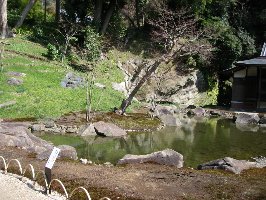
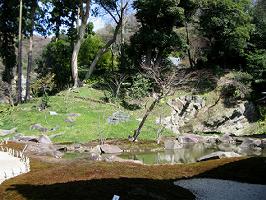
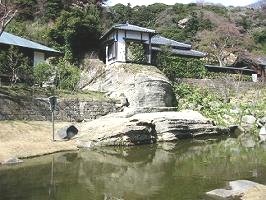
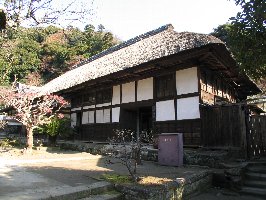
The
Hojo Hall (方丈), the head priest's living quarters, stands behind the
gate, and beyond the hall is a garden with a pond formed in the
shape of the character "心." The character is pronounced shin or
kokoro (meaning heart), and a pond of this shape is called
shinji-ike (心字池), "shin-character pond." In the Hojo Hall, temple
treasures are displayed to the public in early November. Myokochi
Pond (妙香池), is further up to the left. This has been designated a
Place of Scenic Beauty by the government. On the bank beyond the
pond is Kotogan Rock (虎頭岩), literally, "Tiger Head
Rock.
Further up are several
sub-temples: Shozokuin (正続院) with its Shariden Hall (舎利殿),
Butsunichian (仏日庵), and Obaiin (黄梅院). All are worth visiting and are
mentioned below in the section on sub-temples.
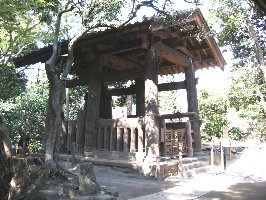
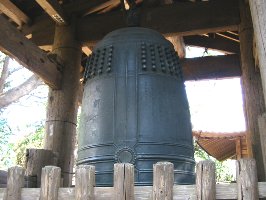
One of the notable
features of Engakuji Temple is its bell, designated a National
Treasure. It is located beside the Bentendo Hall (弁天堂) on the
hillside to the right of the Butsuden Hall. The 2.6-meter-high bell
was made by Mononobe Kunimitsu (物部国光), a caster, by order of Hojo
Sadatoki (北条貞時, 1271-1311), the ninth regent, and is inscribed, 正安三年
(corresponding to 1301). The bell, typical of the Kamakura period,
is the largest in the Kanto region. A waniguchi gong (鰐口), literally
"crocodile mouth," that hangs in the belfry, has the inscription
天文九年 (corresponding to 1540) and is designated an Important Cultural
Property by Kanagawa Prefecture. Bentendo Hall itself was built to
commemorate a legend that says the bell was cast successfully,
thanks to the divine protection of the Benzaiten on Enoshima
Island.
The Sub-Temples, or Tatchu
(塔頭)
It is said that
there were as many as 41 sub-temples, but only 17 remain, most of
which are not open to the public. The following six subtemples are
introduced.
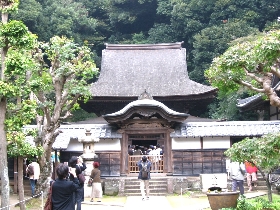
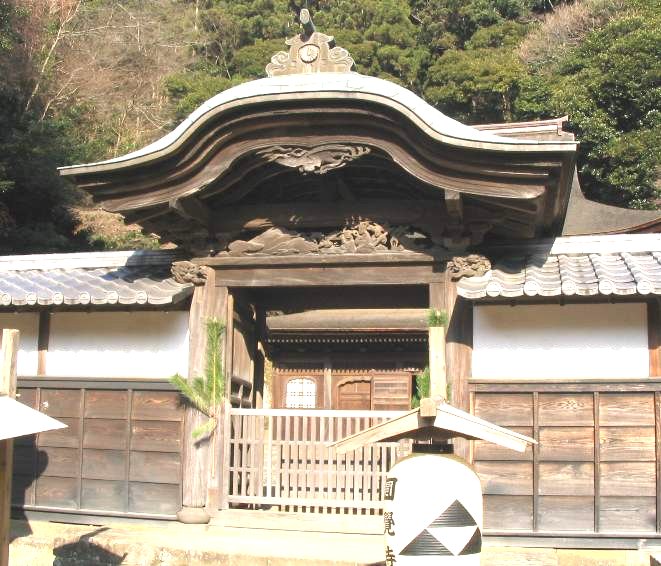

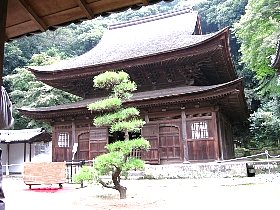
Shozokuin
(正続院)
Shozokuin is
situated to the left beyond Myokochi Pond. Immediately to the right
behind the gate are a hall and subsidiary buildings, which served as
a sub-temple for Mugaku Sogen, the founding
priest.
The structures were
transferred from Kenchoji Temple. In the same area are the Shariden
Hall (舎利殿, a hall for the remains of Shakyamuni), designated a
National Treasure; Kaisando Hall (Founder's Hall), which houses a
statue of Bukko Kokushi (a.k.a. Mugaku Sogen); and a shumidan
platform (須弥壇, a platform on which Buddhist images are displayed);
and a hall for Zen meditation, Shobogendo
(正法眼堂).
The original
Shariden Hall was built in 1285 by Hojo Sadatoki (北条貞時, 1271-1311),
but burned down in 1563. The present-day structure was once the
Butsuden Hall of a convent, Taiheiji (太平寺), in Nishimikado (西御門),
before being transferred to the present location. The structure is
typical of kara-yo (唐様, literally, Chinese-style architecture),
which is also called Zenshu-yo (禅宗様, Zen-sect-style architecture),
and was introduced from China along with Zen Buddhism in the
Kamakura period.
The Hall
has a thick, shingled roof with elaborate rafters and brackets,
finely-worked doors, transoms and windows, and is often described as
elegant, splendid and feminine. The relic of Shakyamuni enshrined in
this hall was supposedly presented by Noninji Temple in China during
the Sung dynasty
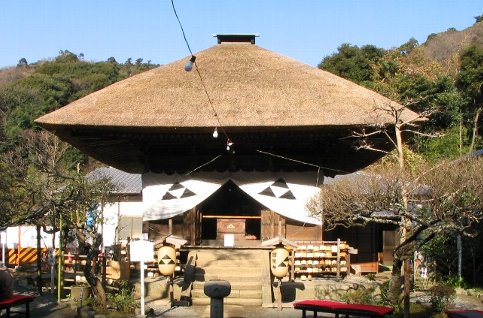 Butsunichian (仏日庵)
Butsunichian (仏日庵)
Butsunichian is located next to Shozokuin on the same side. It is
the mausoleum of Hojo Tokimune, the eighth regent, and later served
as the mausoleum of the head family, tokuso (得宗), of the
Hojo.
The Main Hall, built
in the Edo period, houses three wooden statues: one each of
Tokimune, Sadatoki, and Takatoki (高時, 1303-33, the 14th regent), all
dressed as priests, along with a seated Eleven-faced Kannon statue.
Within the courtyard are two other structures, one called Insokuken
(烟足軒), the other Fukoan (不顧庵). A tea ceremony is held on the fourth
day of every month to commemorate the day Tokimune
died.
Keishoan
(桂昌庵)
Keishoan is located
immediately to the left from the Somon Gate. The hall, also called
Juodo Hall (十王堂), is dedicated to Shosen Dokin (承先道欽). Statues of
the Ten Kings in Hades, including Emma Daio (閻魔大王), are enshrined. A
drill hall for Japanese archery is attached.
Shoreiin
(松嶺院)
Shoreiin is
situated to the left between Keishoan and the Sammon Gate and is
dedicated to Shukuetsu Zen'eki (淑悦禅懌), the one hundred fiftieth head
priest, who died in 1535. Originally, the sub-temple was called
Fukanken (不閑軒). There is a peony garden within the grounds. Arishima
Takeo (有島武郎, 1878-1923), a novelist, wrote the latter part of Aru
Onna, (或る女, A Certain Woman), his best known novel, here. The
graveyard is the resting place for some well-known personalities:
Nakayama Gishu (中山義秀, 1900-69), a novelist, Kaiko Ken (開高健,
1930-89), a novelist and essayist, Shimizu Kon (清水昆, 1912-74), a
cartoonist, Sada Keiji (佐田啓二, 1926-64), a film actor, and Tanaka
Kinuyo (田中絹代, 1909-77), a film actress and director, to name only a
few.
Obaiin (黄梅院)
Obaiin is located at the end of a
path that runs up toward the hills at the rear of the temple
grounds. The structure was built for Muso Soseki by Hogai Koen
(方外宏遠), Soseki's disciple. The Main Hall houses a wooden statue of
Soseki and an image of Yakushi Nyorai (薬師如来). At the far side of the
courtyard is Kannondo Hall, also called Buzando (武山堂), which houses
a statue of Kannon brought from China. The garden is small but worth
visiting because of the abundance of seasonal flowers and blossoms.
Kigen'in (帰源院)
Kigen'in, dedicated to Ketsuo Zeei
(傑翁是英), a.k.a. Butsukei Zenjin (仏恵禅師), is located on the hillside to
the right from the Sammon Gate. References to Kigen'in are found in
two novels: Haru (春, Spring) by Shimazaki Toson (島崎藤村, 1872-1943)
and Mon, (門,The Gate), by Natsume Soseki. Both authors stayed here
temporarily while writing their works. In Mon, Soseki vicariously
confesses through the main character that he was unable to attain
enlightenment.
Temple Treasures: Engakuji is a major
repository of Buddhist treasures. These include items connected with
Mugaku Sogen, the founding priest, and Hojo Tokimune, the founding
patron, as well as paintings, sculptures, and objects used in
Buddhist rituals. Old documents from medieval times, Engakuji Monjo
(円覚寺文書, Documents of Engakuji Temple), are well known and designated
Important Cultural Properties. Of similar design are a wooden seated
statue of Bukko Kokushi, several paintings of the Five Hundred
Arhats (五百羅漢), an incense burner, and letters by Hojo Tokimune.
These treasures are not usually on display, but most of them can be
viewed on November 2nd, 3rd, and 4th, when they are aired.
|
Tokeiji Temple (東慶寺)
|
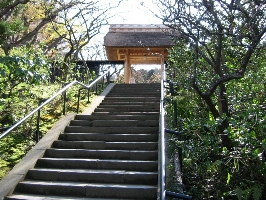
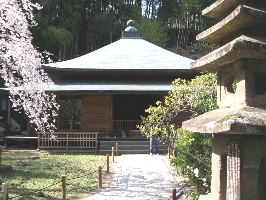
Full name: Shokozan Tokeiji
(松岡山 東慶寺)
Denomination: Rinzai Zen
sect
Location: The temple is situated some 200 meters
south of Kita-Kamakura Station.
History: The temple
was founded in 1285 by Hojo Sadatoki (北条貞時, 1271-1311), the ninth
regent and the son of Hojo
Tokimune.
The founding
abbess was Kakusan Shido (覚山志道, 1252-1306), the wife of Tokimune.
She was also called Kakusan Ni (覚山尼). She became a nun and entered
this temple as the founding nun when her husband, Tokimune, took the
tonsure.
A law called
Engiridera-ho (縁切寺法temple divorce code) is credited to her.
(However, another theory regarding the temple founding says that
Mino no Tsubone (美濃局), the aunt of Minamoto no Yoritomo (源頼朝,
1147-99), founded the temple, and later, Kakusan Ni re-established
it as a Zen temple.)
In
the olden days, a woman could not initiate a divorce unless her
husband agreed, even though he might have been rough, violent, or
inconsiderate. Thus, many women had to endure misfortune all their
lives. To improve the situation, the temple was built so as to
enable a woman to part from her husband on the condition that she
stay here for three full years (later reduced to two) and observe
the temple's rules to the
letter.
As soon as a woman
entered the temple she was questioned about her entire situation by
temple officials, and then her husband, father, and brothers were
summoned through the headman of their town or village. All the
parties concerned were questioned within the temple. When all
present agreed that the couple should part, the husband wrote an
oath to the effect that they were no longer husband and wife.
Because many women fled to the temple to escape husbands in hot
pursuit, the temple came to be called Kakekomidera or Kakeiridera,
literally, Run-in
Temple.
After Kakusan
Ni, other celebrated women succeeded to the position of abbess. The
fifth abbess, Yodo Ni (用堂尼, ?-1396), was the daughter of Emperor
Go-Daigo (後醍醐天皇, 1288-1339), and an elder sister of Prince Morinaga
(護良親王, 1308-35), a.k.a. Moriyoshi. She is said to have entered the
temple to pray for the repose of the soul of her brother, who was
killed by Ashikaga Tadayoshi (足利直義, 1306-52). It was at this time
the temple also came to be called Matsugaoka Gosho
(松ケ岡御所).
The 20th abbess was
Tenshu Ni (天秀尼, 1609-45), the daughter of Toyotomi Hideyori (豊臣秀頼,
1593-1615) and granddaughter of Toyotomi Hideyoshi (豊臣秀吉, 1536-98).
In 1615, she retired here after Osaka Castle, her home, was
destroyed by Tokugawa Ieyasu (徳川家康, 1542-1616). (Earlier, in 1598,
after Hideyoshi died, the Toyotomi and the Tokugawa became rivals
for control of the country. The Toyotomi held themselves in Osaka
Castle to fight off the Tokugawa, but eventually the castle was
destroyed and many of the Toyotomi were killed. This was how
Tokugawa Ieyasu brought about the unification of Japan.) In the Edo
period, many women were granted refuge by the temple and the number,
it is said, increased toward the end of the
period.
The temple owned
large tracts of land in the Edo period, including the present
grounds of Kamakuragu Shrine in Nikaido (二階堂). As the tomb of Prince
Morinaga was under the care of this temple, Kamakuragu Shrine was
built in Nikaido in the Meiji period and dedicated to the
prince.
In 1903, Tokeiji was
converted from a convent to a temple under Furukawa Gyodo (古川尭道,
1872-1961).
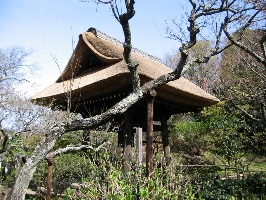
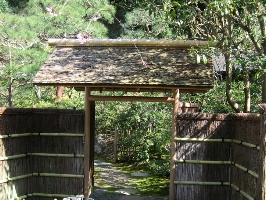
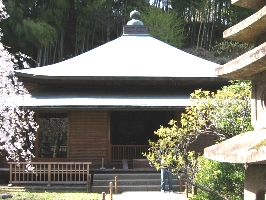
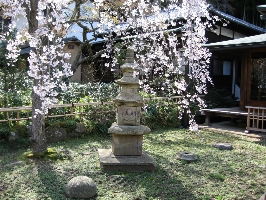
Temple Grounds: At the corner of the
approach is a gatepost with the characters 松ケ岡 (Matsugaoka), which
is another name for the temple deriving from the sango, 松岡山
(Shokosan). The temple is also popularly known as Kakekomidera
(駆け込み寺), "Refuge Temple" or Kakeiridera (駆け入り寺), "Run-in Temple",
and, additionally, Engiridera (縁切り寺), "Divorce
Temple."
By taking the
approach lined with pine trees and a flight of stone steps, you will
see a thatched Sammon Gate at the top. Beyond the gate to the left
is a belfry. The bell, brought from Fudarakuji Temple (補陀洛寺), bears
the era name 観応元年 (corresponding to
1350).
The Butsuden
Hall, called Taiheiden (太平殿), is built in the hogyo-zukuri style
(方形造り), four equal sides and a square roof with the four slopes
meeting in a point at the top. The Hall possesses statues of Shaka
Nyorai, Kakusan Ni, and Yodo
Ni.
The Kannondo Hall, also
called Suigetsudo (水月堂), houses images of Suigetsu Kannon (水月観音) and
Shotoku Taishi (聖徳太子, 574-622). The former, made in the Muromachi
period, has an elegant and delicate demeanor, and is designated an
Important Cultural Property by Kanagawa
Prefecture.
Further to the
left is a treasure hall called Matsugaoka-hozo (松ガ岡宝蔵). Among the
many fine items here is the statue of Sho Kannon (聖観 - designated an
Important Cultural Property), made under the influence of Sung (宋)
China, with decorative clay patterns on its
robe.
Hatsune Makie Hitorimo
(初音蒔絵火取母), also an Important Cultural Property, is a pumpkin-shaped
incense burner with six rounded sides and is presumed to have been
made in the Muromachi
period.
Budo Makie
Seibei-bako (葡萄蒔絵聖餅箱), a rare item related to Christianity, is a box
for the sacramental wafer and is designated an Important Cultural
Property. It is a cylindrical, gold-lacquered mother-of-pearl
container with an exotic design. On the lid are the letters (IHS,(
an acronym for Jesus, with a flower designed in the shape of a cross
and three thorns symbolizing the Passion, all encircled by a
halo.
Other objects are
umpan (雲版) - a gold-lacquered box, a painting of Tenshu Ni, some old
documents, and written oaths of
divorce.
To the right on the
hillside just after the treasure house is a library called
Matsugaoka Bunko (松ガ岡文庫). It was built in 1941 and possesses
materials related to the world-famous Zen Buddhist philosopher,
Suzuki Daisetsu. It is not open to the public.
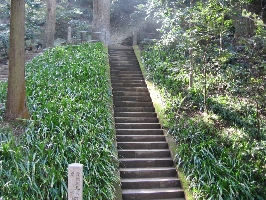
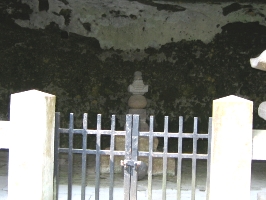
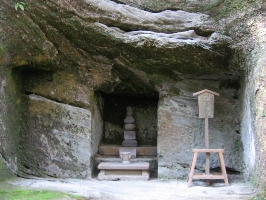
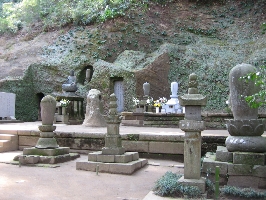
There are cemeteries
at the rear of the grounds. One of them can be reached by taking the
stone steps up the hillside to the right, and you will see tombs of
successive abbesses: that of Tenshu Ni, the biggest in the center,
and of Yodo Ni and Kakusan Ni in the caves behind. In another
cemetery are the tombs of many celebrated persons: famous scholars,
literary men and women, and business people.
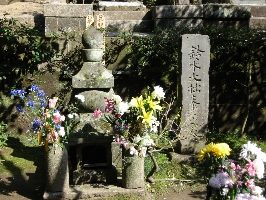
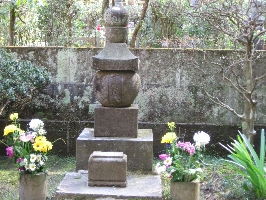
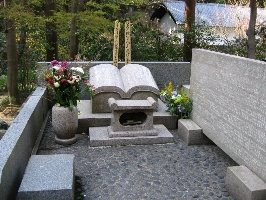
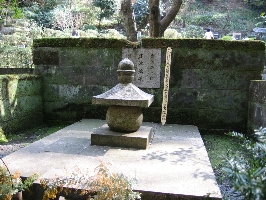
Among
them are Nishida Kitaro (西田幾多郎、philosopher, 1870-1945); Suzuki
Daisetsu (鈴木大拙、philosopher, 1870-1966); Watsuji Tetsuro
(和辻哲郎、philosopher, 1889-1960); Tamura Toshiko (田村俊子、novelist,
1884-1945); Nogami Yaeko (野上弥生子、novelist, 1885-1985); Takami Jun
(高見順、novelist, 1907-65); Ota Mizuho (太田瑞穂、poet, 1876-1955); Nogami
Toyoichiro (野上豊一郎、Noh scholar, 1883-1950); Maeda Seison
(前田青邨、Japanese-style painter, 1885-1977); Kobayashi Hideo
(小林秀雄、critic, 1902-83); Nakagawa Zennosuke (中川善之助、law scholar,
1897-1975); Iwanami Shigeo (岩波茂雄、founder of Iwanami Shoten
Publishing Company, 1881-1946); Abe Yoshishige (安倍能成、philosopher and
educator, 1883-1966) and Daimatsu Hirofumi (大松博文、 1921-78), to name
only a few.
The Butsuden
Hall that was once in these grounds was transferred to Sankeien Park
in Yokohama. It was a typical, late-Muromachi Zen-style work.
Jochiji Temple
(浄智寺)
|
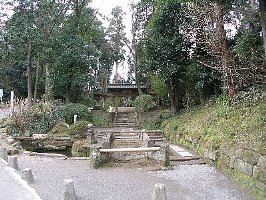
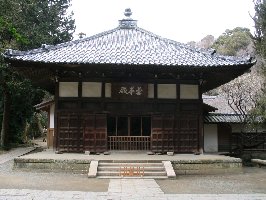
Full name: Kinposan (金宝(or 峰)山)
Jochiji
Denomination: Rinzai sect
(臨済宗)
Location: Some 400 meters south of Kita-Kamakura
Station
History: The temple was built around 1281. Its
founders were Hojo Munemasa (北条宗政, 1253-81), the third son of Hojo
Tokiyori, and Hojo Morotoki(北条師時, 1275-1311), a grandson of
Tokiyori. There were two founding priests, Gottan Funei (兀菴普寧,
?-1276) and Daikyu Shonen (大休正念, a.k.a. Butsugen Zenji 仏源禅師,
1215-1289), and one sub-founder, Nanshu Kokai (南洲宏海, a.k.a. Shin'o
Zenji, 真応禅師, ?-1303).
A
story connected with these founders relates that when Munemasa died
young, his wife had a temple built in his honor, appointing her late
husband and her son, Morotoki, as its patrons, and inviting Kokai to
be the founding priest. Kokai declined the honor, explaining that he
felt himself too young and immature to accept it. Instead, he then
asked his master, Shonen, to assume the position, but Shonen in turn
passed the honor on to his own teacher, Funei.
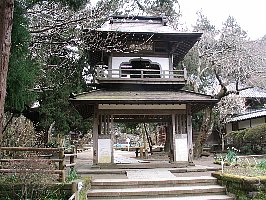
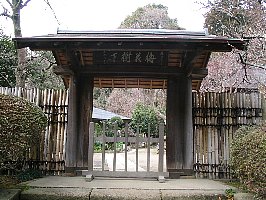

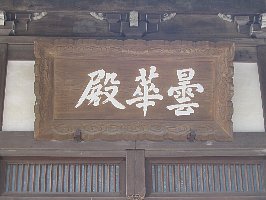
Grounds and structures: The temple sits back about
50 meters from the main road. Greenery abounds within the precincts,
which have the atmosphere of an old Zen temple. The area is
designated a National Historic
Site.
A weathered bridge
spans a small, old pond, and to the left is Kanro no I Well (甘露ノ井),
one of the ten famous wells of old
Kamakura.
The Somon Gate is
visible from here. A plaque on the gate bears the characters 寶所在近,
hosho-zaikin. They were written by Mugaku Sogen and mean, in today's
parlance, that the treasure one seeks is to be found nowhere other
than in one's own
backyard.
Beyond the
Somon Gate and a flight of stone steps stands a two-story Sammon
Gate. The structure is very rare because of the belfry on the second
story, which contains a bell made in
1340.
Beyond the gate and to
the right is the Butsuden Hall (仏殿), called Dongeden (曇華殿).
Enshrined inside are three images of Buddha: Amida (阿弥陀), Shaka
(釈迦), and Miroku (弥勒), who are believed to preside in the past,
present and future worlds,
respectively.
The temple
is not so large now, but in its heyday it had eleven sub-temples and
a large number of monks served here. Regarded as one of the five
great Zen temples of Kamakura, it ranked fourth in
prosperity.
Visitors are
free to stroll around the grounds from the left side of the Butsuden
Hall. Beyond the hall are many old trees, among which are koya-maki
(高野槙) and hakuumboku (白雲木 or sarasoju, 沙羅双樹).
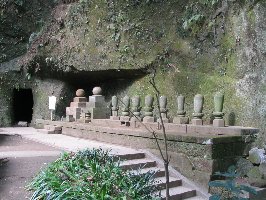
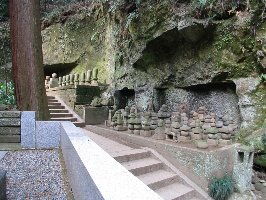
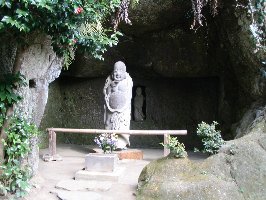
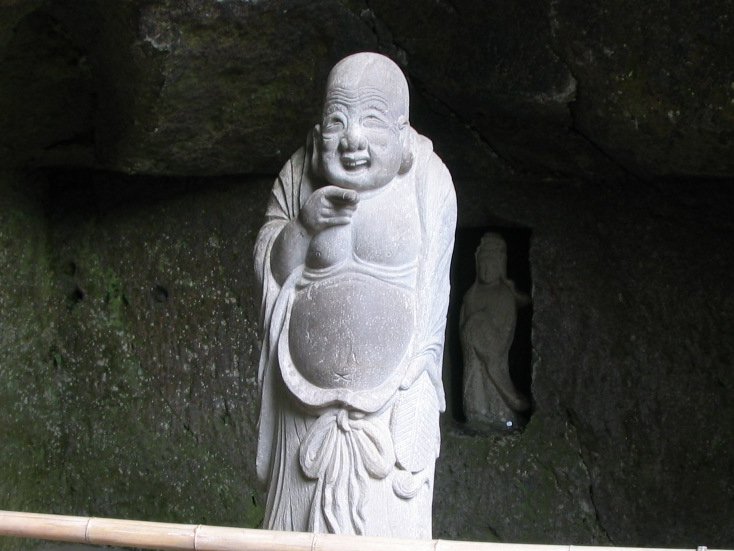
At the
rear of the grounds is a stone statue of Hoteison (布袋尊), the god of
Good Fortune, who is also one of the Seven Deities of Good Fortune
in the Kamakura and Enoshima
area.
The Seven Gods are
Benzaiten (弁才天) at Tsurugaoka Hachimangu Shrine, Hoteison at Jochiji
Temple, Jurojin (寿老人) at Myoryuji Temple (妙隆寺), Ebisu (恵比寿) at
Hongakuji Temple (本覚寺), Bishamonten (毘沙門天) at An'yoin Temple (安養院),
Daikokuten (大黒天) at Hasedera Temple (長谷寺), and Fukurokuju (福禄寿) at
Goryo Jinja Shrine (御霊神社) in Hase. The Benzaiten on Enoshima Island
(江ノ島) is also included among these Seven
Gods.
The temple
treasures are an image of Jizo Bosatsu dating from the Kamakura
period (an Important Cultural Property), and a Letter of
Solicitation (an Important Cultural Property) by Gyokuin Eiyo for
the repair of Sairaian Hermitage (西来庵) at Kenchoji Temple. Both are
presently on loan to Kamakura Kokuhokan (鎌倉国宝館).
|
Yakumo Shrine (八雲神社)
|
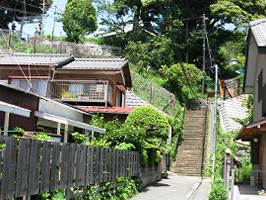
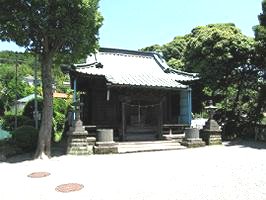
Location: 0.2
kilometers north-east of JR Kikatamakura
Station.
History:
The shrine was originally
called Gozu Tennosha (牛頭天王社) and was dedicated to
Susanoo no Mikoto (素盞鳴命), a legendary deity in
Japanese mythology. In the middle of the fifteenth
century, Uesugi Norifusa (上杉憲房, 1467-1525)
replaced the shrine with the deity of Yasaka
Shrine (八坂神社) in Kyoto, and gave the new shrine
the name Yakumo Shrine. In those days the
Yamanouchi Uesugi family (山ノ内上杉), to which
Norifusa belonged, and the Ogigayatsu Uesugi
(扇ガ谷上杉) were vying for power in Kamakura-fu (鎌倉府).
Norifusa allegedly had the shrine rebuilt in the
hope of success in the power struggle and to
prevent the spread of the
plague.
Grounds and structures:
On the top of a flight of
stone steps stands a shrine dedicated to a
tutelary deity of the Yamanouchi
area.
Beyond the torii
(鳥居), shrine gate, are four structures: Honden
(Main Hall), Haiden (Worship Hall), massha (末社,
subordinate shrine), and a repository for a
mikoshi (神輿), portable shrine.
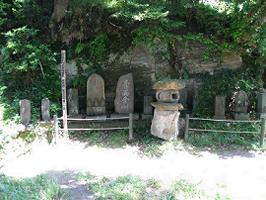 Behind the
repository for the portable shrine is a
koshinto-type (庚申塔) stone monument with the
inscription "寛文五年" (corresponding to 1665) along
with ten other monuments. It is well known because
it is the oldest and the largest for its kind in
Kamakura.
Behind the
repository for the portable shrine is a
koshinto-type (庚申塔) stone monument with the
inscription "寛文五年" (corresponding to 1665) along
with ten other monuments. It is well known because
it is the oldest and the largest for its kind in
Kamakura.
The
shrine festival is held from the 15th through the
20th of July every year, in which the passage of
the portable shrine has been restored. Formerly
five men and two women, who wore masks (made in
1840) and costumes of those days, marched in a
procession, but it is discontinued. Now these
masks are on display on the roadside.
Seimei no Ishi Stone (清明の石)
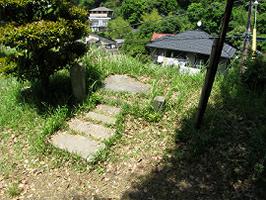
Within the grounds of Yakumo Shrine is a large
stone, around which one barely put one's arms. It
is called Seimei no Ishi and is deified. The stone
was transferred from a location nearby the
Juodobashi Bridge
(十王堂橋).
The "Seimei"
in Seimei no Ishi derives from a celebrated
ommyoji (陰陽師), an ancient fortuneteller, named Abe
no Seimei (安倍清明, 921-1005), who lived in the Heian
period. The ommyodo (陰陽道), literally, "the way of
yin (being negative or passive, 陰 in Japanese) and
yang (being positive or active, 陽 in Japanese),"
evolved mainly in the seventh century after the
introduction of the ancient Chinese theories of
yin and yang and the five elements (wood, fire,
earth, gold, and water) which compose the
universe. According to this belief, the ebb and
flow of yin and yang bring about all natural and
social phenomena in the world. Even today, the
date of a wedding or a funeral service, the start
of construction for a new house and other
important events are often decided in accordance
with this theory of yin and
yang.
Legend says that
if people step on this Seimei no Ishi Stone
unwittingly, their legs will become strong; but if
the same thing is done knowingly, their legs or
health will weaken. Local people have deified the
stone, believing that it protects them from fire
and any kind of disaster.
|


 The"Engaku" (
The"Engaku" (





















 Butsunichian (
Butsunichian (

























 Behind the
repository for the portable shrine is a
koshinto-type (
Behind the
repository for the portable shrine is a
koshinto-type (